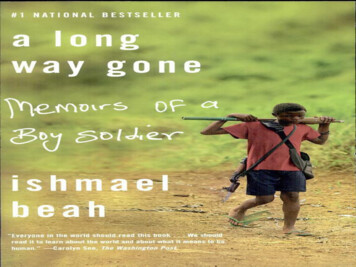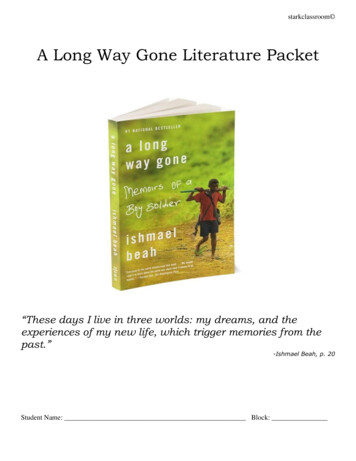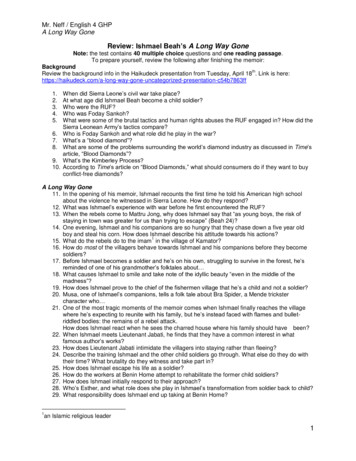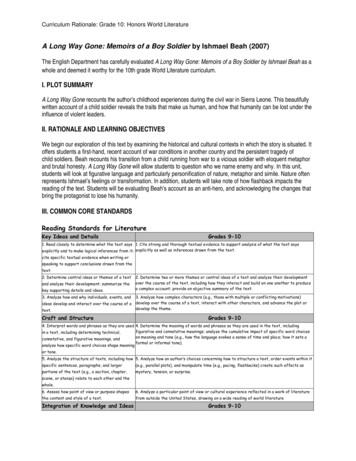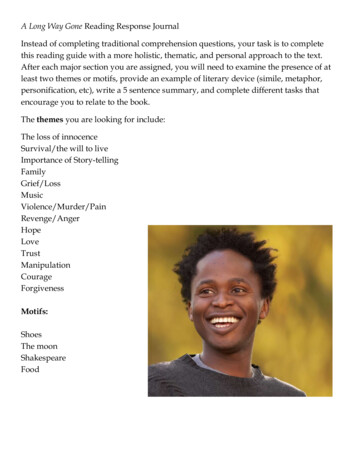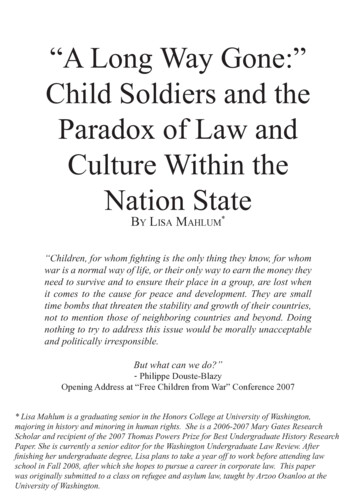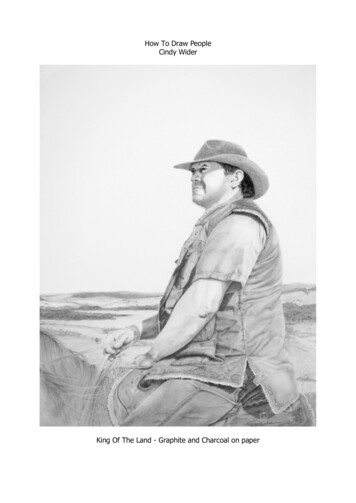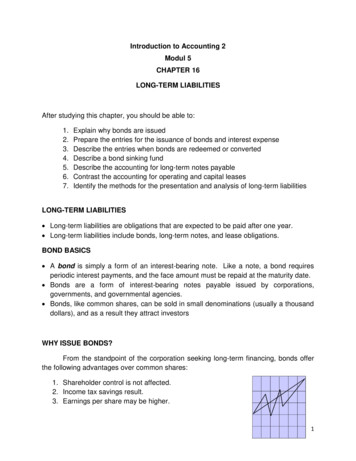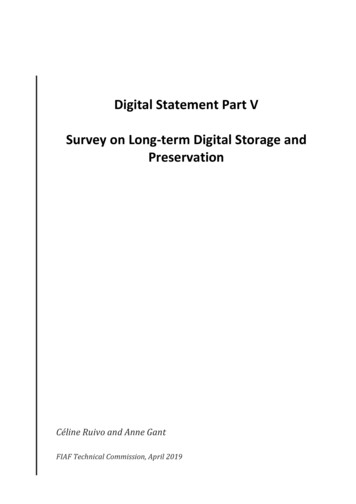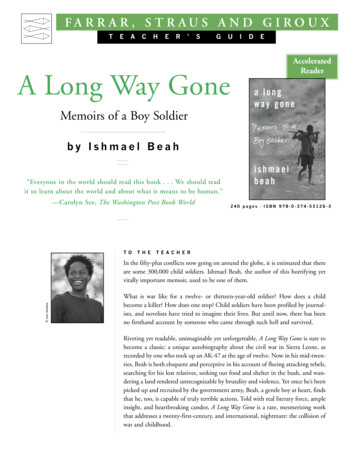
Transcription
FA R R A R , S T R AU S A N D G I RO U XTEACHER’SGUIDEAcceleratedReaderA Long Way GoneMemoirs of a Boy Soldierby Ishmael Beah“Everyone in the world should read this book . . . We should readit to learn about the world and about what it means to be human.”—Carolyn See, The Washington Post Book WorldT OT H E240 pages ISBN 978-0-374-53126-3T E A C H E R John MadereIn the fifty-plus conflicts now going on around the globe, it is estimated that thereare some 300,000 child soldiers. Ishmael Beah, the author of this horrifying yetvitally important memoir, used to be one of them.What is war like for a twelve- or thirteen-year-old soldier? How does a childbecome a killer? How does one stop? Child soldiers have been profiled by journalists, and novelists have tried to imagine their lives. But until now, there has beenno firsthand account by someone who came through such hell and survived.Riveting yet readable, unimaginable yet unforgettable, A Long Way Gone is sure tobecome a classic: a unique autobiography about the civil war in Sierra Leone, asrecorded by one who took up an AK-47 at the age of twelve. Now in his mid-twenties, Beah is both eloquent and perceptive in his account of fleeing attacking rebels,searching for his lost relatives, seeking out food and shelter in the bush, and wandering a land rendered unrecognizable by brutality and violence. Yet once he’s beenpicked up and recruited by the government army, Beah, a gentle boy at heart, findsthat he, too, is capable of truly terrible actions. Told with real literary force, ampleinsight, and heartbreaking candor, A Long Way Gone is a rare, mesmerizing workthat addresses a twenty-first-century, and international, nightmare: the collision ofwar and childhood.
PRAISE FORA LONG WAY GONE“[Beah’s] honesty is exacting, and a testament to the ability of children ‘to outlivetheir sufferings, if given a chance.’” —The New Yorker“This remarkable firsthand account shows how civil strife destroys lives . . . Thehorrors [Beah] saw or perpetrated still haunt him and will be difficult for thereader to forget . . . Beah writes his story with painful honesty, horrifying detail,and touches of remarkable lyricism. This young writers has a bright future . . . Aschildren fight on in dreadful wars around the globe, Beah’s story is a must for everyschool.” —Rayna Patton, VOYA“Beah’s autobiography is almost unique, as far as I can determine—perhaps thefirst time that a child soldier has been able to give literary voice to one of the mostdistressing phenomena of the late 20th century: the rise of the pubescent (or evenprepubescent) warrior-killer . . . Beah’s memoir joins an elite class of writing:Africans witnessing African wars . . . A Long Way Gone makes you wonder howanyone comes through such unrelenting ghastliness and horror with his humanityand sanity intact.” —William Boyd, The New York Times Book Review“Beah’s is a story of loss and redemption—from orphan to fighter to internationalparticipant in human-rights conferences on child soldiers. While his account ofloss is painful to read . . . it is his account of rehabilitation that most occupies thereader’s mind—how these children who become addicted to drugs and violence areable to re-enter the world of civil society.” —Jeff Rice, Chicago Tribune“Terrifying, often graphic in portraying the violence he both witnessed and carriedout as a barely adolescent soldier in Sierra Leone, 26-year-old Beah’s story is alsodeeply moving, even uplifting . . . Reports about child soldiers and the crises inAfrica proliferate, but Beah’s story, with its clear-eyed reporting and literate particularity—whether he’s dancing to rap, eating a coconut or running toward theburning village where his family is trapped—demands to be read.” —People“It would have been enough if Ishmael Beah had merely survived the horrorsdescribed in A Long Way Gone. That he has written this unforgettable firsthandaccount of his odyssey is harder still to grasp. Those seeking to understand thehuman consequences of war, its brutal and brutalizing costs, would be wise toreflect on Ishmael Beah’s story.” —Chuck Leddy, The Philadelphia Inquirer“Beah’s story is a wrenching survivor’s tale, but there’s no self-pity or politicaldigression to be found. Raw and honest, A Long Way Gone is an important accountof the ravages of war, and it’s most disturbing as a reminder of how easy it wouldbe for any of us to break, to become unrecognizable in such extreme circumstances. . . Beah’s uncompromising voice is a potent elegy for their suffering, a powerfulreminder of the innocent casualties of war.” —The Miami Herald2
P R E PA R I N GT O R E A DThis teacher’s guide consists of three sections: Reading and Understanding theBook, Questions and Exercises for the Class, and Terms to Define and Discuss.The first section will help students follow along with ; the second will aid in theirexploration of, and reflection on, this memoir (as individuals and as a group); andthe third will sharpen their comprehension of Beah’s work via definition, termidentification, and review. Teachers looking for additional historical or politicalcontext will note that the book itself includes an introductory map and a detailedchronology of Sierra Leone-related events.R E A D I N G A N DU N D E R S TA N D I N GT H E B O O K1. How did Ishmael Beah’s grandmother explain the local adage that “we muststrive to be like the moon” (p. 16)? And why has Ishmael remembered this sayingever since childhood? What does it mean to him?2. As Chapter 2 begins, we flash forward to Ishmael’s new life in New York City.He relates a dream of pushing a wheelbarrow. What is in the wheelbarrow, andwhere is he pushing it? What does Ishmael mean when he says, “I am looking atmy own” (p. 19)?3. “That night for the first time in my life,” writes Ishmael in Chapter 3, “Irealized that it is the physical presence of people and their spirits that gives a townlife” (p. 22). What prompts him to observe this? How old is he at the time? Also,who are the five boys with whom Ishmael flees at the end of this chapter?4. Why, after their escape, do Ishmael and the other boys sneak back into thevillage of Mattru Jong?5. Commenting on how a rebel soldier had interrogated an old man, Ishmaelwrites: “Before the war a young man wouldn’t have dared to talk to anyone olderin such a rude manner. We grew up in a culture that demanded good behaviorfrom everyone, and especially from the young” (p. 33). Where else in A Long WayGone did you encounter the brutal, thuggish, or even sadistic behavior of youngrebels—or of other young people?6. In Chapter 6, how and why do Ishmael and his companions start farming in thevillage of Kamator? Why is farming so difficult for Ishmael?7. After Kamator has been attacked, and the two boys have been cut off from theothers in fleeing, Ishmael and Kaloko sneak out of the bush and back intoKamator, bringing along brooms every time. Why do they bring brooms? Andwhy, later, does Ishmael set out on his own?3
8. What does Ishmael tells us was the “most difficult part of being in the forest” (p.52)? And who are the six boys Ishmael encounters after wandering and surviving inthe forest on his own for more than a month? Where does he know some of theseboys from?9. Who is the anonymous man with the fishing hut near the ocean, and how doeshe help to soothe and heal the severely scalded feet of Ishmael and the others? Andlater, how are the lives of all seven boys saved by rap music—specifically the musicof LL Cool J?10. Describe the “name-giving ceremony” (p. 75) that Ishmael recollects his grandmother telling him about. Who attended this ceremony, and what did it entail inthe way of preparation, purpose, ritual, and food? Also, what do we learn in Chapter10 of the various backgrounds of Ishmael’s companions? And how does Saidu die?11. Who is Gasemu? Why does Ishmael befriend him and then later try to stranglehim?12. At the village of Yele, a pivotal shift in this memoir begins when Ishmael goesfrom being an observer and victim of savage, war-triggered violence to being bothof these things as well as a perpetrator of such violence. How does this shift happen?Do Ishmael and his companions have any choice in making it?13. In Chapter 13, the boy soldiers are given white tablets by their army superiors.What are these? Why they being handed out?14. What do Ishmael and the other boy soldiers do when they’re not out on amission? What movies do they like to watch, and why? What else to they do withtheir spare time? At one point, the lieutenant tells them, “We are not like the rebels,those riffraffs who kill people for no reason” (p. 123). Is this true? Also, why isIshmael promoted to junior lieutenant? How did he achieve this new rank?15. As Chapter 15 begins, a dreadful, nightmarish routine is, by now, firmly inplace—“In my head my life was normal,” Ishmael writes (p. 126). How long has hebeen a soldier? And what happens to Ishmael and Alhaji, and a few other selectboys, in the town of Bauya? Where are they taken, and by whom?16. Who is Mambu? Why does Ishmael take a liking to him? And who is Esther,and why does Ishmael—later on—take a liking to her?17. Benin Home, where Ishmael undergoes psychological, emotional, and socialcounseling, as well as physical and medical attention, is where he keeps hearing the“this isn’t your fault” remark from various staffers and professionals. Does he everreally accept this mantra? Explain.18. In Chapter 17, Ishmael describes “the first time [he’d] dreamt of [his] familysince [he] started running away from the war” (p. 165). Paraphrase this nightmare,explaining how it differs from the many other dreams we’ve heard about fromIshmael. Also, explain how the dream illustrates his inner conflicts.4
19. As he is leaving Benin Home, Ishmael says farewell to his friend Alhaji, whosalutes him while whispering, “Goodbye, squad leader.” “I couldn’t salute him inreturn,” Ishmael writes (p. 180). Why?20. Describe the family Ishmael goes to live with after his eight-monthrehabilitation. Who are they? How is he related to them? What does he think ofthem? Is he entirely honest with them? Which members of his new family is Ishmaelclosest to?21. What is the “open metal box” (p. 186) that Ishmael is so confused by? Why andwhere has he encountered this box?22. How does Ishmael’s experience of New York City differ from what he had pictured beforehand? What does he like most about New York? What doesn’t he like?And why is he visiting New York in the first place? Identify some of the meaningful personal and professional contacts that our narrator makes there.23. How does Uncle Tommy die? And how, if at all, is his death facilitated or eventriggered by the civil war fighting that has reached Freetown and its environs?24. This memoir ends with a striking image, as Ishmael sees a mother telling hertwo children a story that he had also heard as a child. It’s a memorable fable thattouches on several of the key themes of this book, including violence, family, storytelling, childhood, and African village life. But it also carries a message of sacrifice.Explain how this last message also reverberates throughout A Long Way Gone.25. Look back to the short “New York City, 1998” prologue that begins this memoir. What is it, exactly, that Ishmael’s friends find so “cool” about his past? Do youthink his friends, after reading this book, would still feel that way? Why or why not?QUESTIONS ANDEXERCISESFOR THE CLASS1. As a class or in smaller, more focused groups, begin your discussion of A LongWay Gone by talking about what you learned from the book on an historical level.What did Ishmael’s personal history communicate to you about the recent historyof his homeland?2. This book describes two kinds of domestic living in detail, village life and citylife. Which does Ishmael prefer, and why?3. Violence is, of course, a major theme in these pages—physical, psychological,social, and otherwise. Indeed, some of the more violent passages in this book makefor very difficult if not unsettling reading. In a brief essay, reflect on what Ishmael’smany violent experiences taught you about the consequences or aftereffects, bothintended and unintended, of violence.5
4. What kinds of music does Ishmael like, and why? What is it about music thatmatters to Ishmael, or that moves him so? Why is it important to him, especiallyduring his rehabilitation at Benin Home?5. “I could no longer tell the difference between dream and reality” (p. 15),Ishmael writes early in his tale. Indeed, memories, dreams, and troubling orinescapable thoughts are perhaps even more important to this book than firsthandevents and actions are. Talk about A Long Way Gone as a psychological memoir,comparing and contrasting it with other works you have experienced in this vein.6. Review the tale of the “wild pigs” (p. 53) that Ishmael learned about from hisgrandmother, and the “Bra Spider” story (p. 75) that Musa tells Ishmael at theother boys. What other myths or legends did you come across in this book? Afternaming a few, explain the particular narrative and cultural purposes of each.7. Nature is often personified in A Long Way Gone. Point out several instances ofthis—from throughout the memoir—and then write a short poem or story thatemploys anthropomorphism in a similar manner.8. Shakespeare’s Julius Caesar is an important reference point in A Long Way Gone.Which individual, other than Ishmael, is familiar with it, and why do you thinkthat person is always reading it? Read this play on your own, or at least study itskey speeches and monologues (namely, those mentioned throughout this book),and then explain how the themes and events of Shakespeare’s play might echoIshmael’s memoir.9. Early in his account, Ishmael laments how “the war had destroyed the enjoyment of the very experience of meeting people” (p. 48). Where else does he expressthis fact, or else suffer from its consequences? As a class, discuss the book’s ongoing struggle between trust and survival. Can these two phenomena coexist?10. A Long Way Gone is a book with much to say on the subject of family:family life, family relationships, and family environment. Write a short paper thatcatalogs and characterizes the many different families that Ishmael has belonged toover the course of his young life.11. How are “civilians” depicted in this book? How are they thought of? How arethey treated? As a class, explore how our narrator’s relationship with them changesover time.12. Finally, discuss this harrowing account of civil war and childhood as a meditation on finding one’s ultimate purpose. How does Ishmael, at a relatively early age,arrive at what seems to be his calling in life?6
TERMS TO DEFINEAND DISCUSScrapes (p. 7)kamor (p. 8)lorry (p. 10)cassava (p. 17)RUF (p. 21)palampo (p. 23)RPGs (p. 24)sleepers (p. 27)imam (p. 44)sura (p. 44)waleh (p. 51)Nessie (p. 51)Temne (p. 55)Mende (p. 55)soukous (p. 59)jerry cans (p. 59)Sherbro (p. 63)carseloi (p. 71)spirogyra (p. 73)pestles (p. 76)lappei (p. 76)leweh (p. 76)Ngor (p. 91)gari (p. 91)wahlee (p. 98)brown brown (p. 121)tafe (p. 137)kalo kalo (p. 150)repatriate (p. 171)kule (p. 177)sackie thomboi (p. 181)ablution (p. 182)raggamorphy (p. 183)upline (p. 184)poda podas (p. 185)SLPP (p. 188)groundnut (p. 188)CAW (p. 188)United Nations FirstInternational Children’sParliament (p. 195)NGOs (p. 196)UN ECOSOC (p. 199)“Sobels” (p. 203)G3 (p. 207)Conakry (p. 209)ABOUT THE AUTHORIshmael Beah was born in Sierra Leone in 1980 and moved to the U.S. in 1998.In 2004 he graduated from Oberlin College with a B.A. in political science. He isa member of Human Rights Watch Children’s Division Advisory Committee, andhas spoken before the United Nations, the Council on Foreign Relations, and theCenter for Emerging Threats and Opportunities (CETO) at the Marine CorpsWarfighting Laboratory. Beah’s writing has appeared in VespertinePress and LITmagazine. He lives in New York City.Scott Pitcock, who wrote this teacher’s guide, is an editor and writer based in Tulsa,Oklahoma.7
PRESORTED STDU.S. POSTAGEPAIDFOND DU LAC, WIPERMIT NO. 317FREE TEACHER’S GUIDES AVAILABLE FROM MACMILLANTHE 9/11 REPORT, Jacobson & ColónALL BUT MY LIFE, Gerda Weissmann Klein*ANNE FRANK, Jacobson & ColónANNIE JOHN, Jamaica Kincaid*BETSEY BROWN, Ntozake Shange*Building Solid Readers (A Graphic Novel Teacher’s Guide)ESCAPE FROM SLAVERY, Francis Bok*I AM A SEAL TEAM SIX WARRIOR, Howard E. Wasdin & Stephen Templin*I CAPTURE THE CASTLE, Dodie Smith*I NEVER PROMISED YOU A ROSE GARDEN, Joanne Greenberg*THE ILIAD, trans., Robert Fitzgerald*THE INFERNO OF DANTE, trans., Robert PinskyLIE, Caroline Bock*LIKE ANY NORMAL DAY, Mark Kram, Jr.*A LONG WAY GONE, Ishmael BeahMIDNIGHT RISING, Tony HorwitzMY SISTERS’ VOICES, Iris Jacob*THE NATURAL, Bernard Malamud*NAVY SEAL DOGS, Michael Ritland*NICKEL AND DIMED, Barbara EhrenreichNIGHT, Elie WieselTHE NIGHT THOREAU SPENT IN JAIL, Lawrence & Lee*THE ODYSSEY, trans., Robert FitzgeraldRAY BRADBURY’S FAHRENHEIT 451, Tim HamiltonROBERT FROST’S POEMS, Robert FrostA RUMOR OF WAR, Philip Caputo*SOPHIE’S WORLD, Jostein GaarderSTONEWALL’S GOLD, Robert J. Mrazek*THIS I BELIEVE, Allison & Gediman, editorsUPSTATE, Kalisha Buckhanon*WE JUST WANT TO LIVE HERE, Rifa’i & Ainbinder*WIT, Margaret Edson*A YELLOW RAFT IN BLUE WATER, Michael Dorris* Online Exclusive! Please visit www.MacmillanAcademic.com.Printed on 30% recycled post-consumer waste paperA L O N G W A Y G O N E Teacher’s Guide ISBN 0-374-95085-7 Copyright 2011 by MacmillanMacmillan is pleased to offer these free Teacher’s Guides to educators. All of our guides areavailable online at our website: www.MacmillanAcademic.com.If you would like to receive a copy of any of our guides by postal mail, please email your requestto academic@macmillan.com; fax to 646-307-5745; or mail to Macmillan Academic Marketing,175 Fifth Avenue, 21st floor, New York, NY 10010.
insight, and heartbreaking candor, A Long Way Gone is a rare, mesmerizing work that addresses a twenty-first-century, and international, nightmare: the collision of war and childhood. A Long Way Gone Memoirs of a Boy Soldier TO THE TEACHER by Ishmael Beah 240 pages ISBN 978-0-

